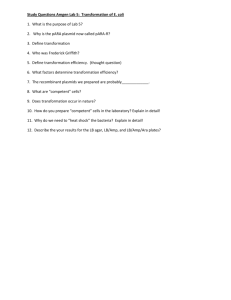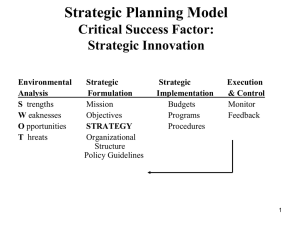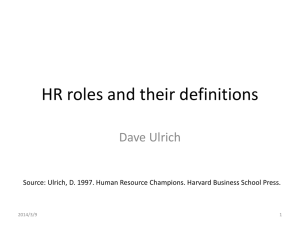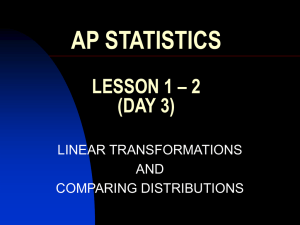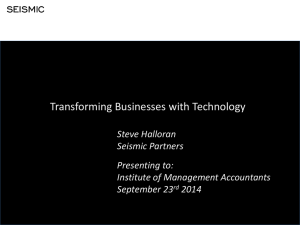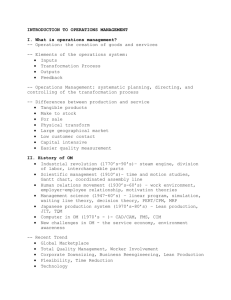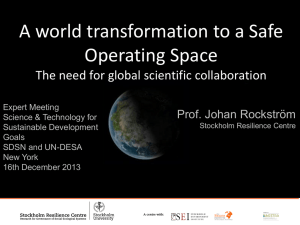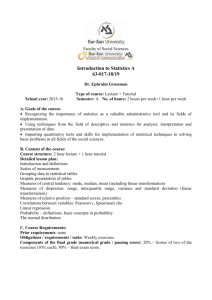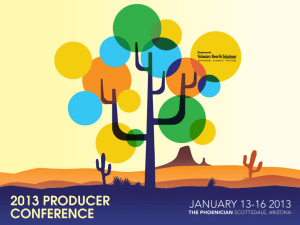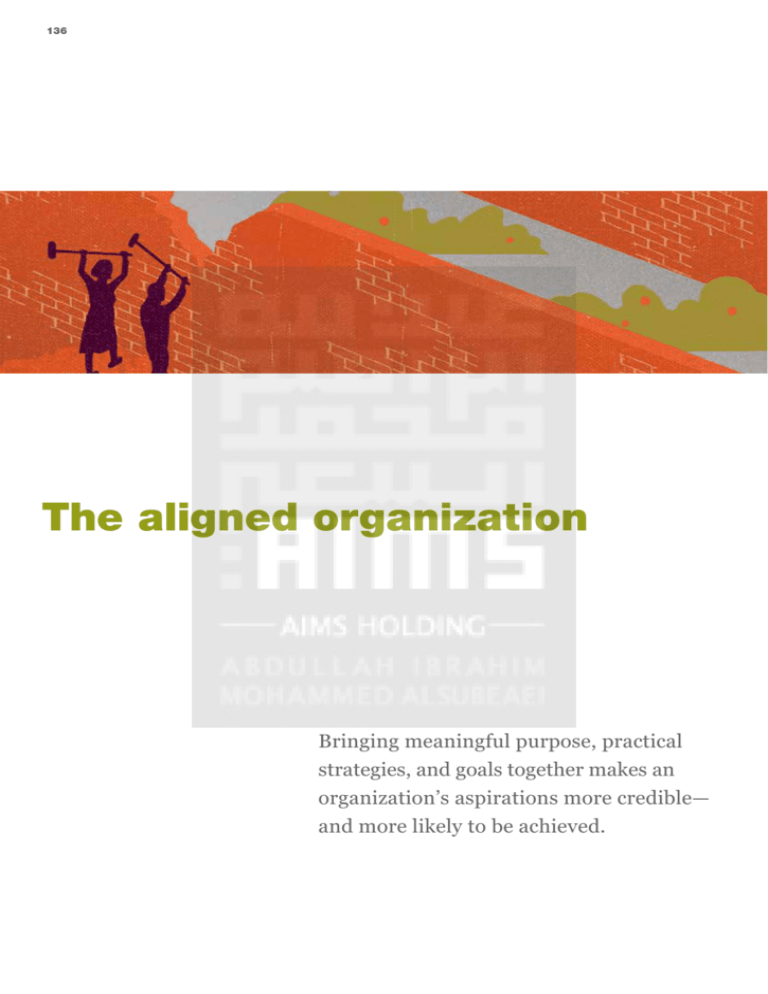
136
The aligned organization
Bringing meaningful purpose, practical
strategies, and goals together makes an
organization’s aspirations more credible—
and more likely to be achieved.
137
Thierry Nautin
Think of a successful organization,
But some organizations make all of the links,
regardless of industry. One of the measures of
so that vision, strategy, and goals come together
an organization’s success is its agility—whether it
to become meaningful work. In so doing they
manages to stay at least one step ahead of its
instill a sense of achievement that, in turn, enables
market. Achieving real alignment, where strategy,
their people to achieve more and more.
goals, and meaningful purpose reinforce one
another, gives an organization a major advantage
Vision to strategy to goals
because it has a clearer sense of what to do at
Organizations that are starting their transforma-
any given time, and it can trust people to move in
tions typically find themselves in one of two
the right direction. The result is an organi-
categories when it comes to their visions. The
zation that can focus less on deciding what to
larger category consists of organizations
do—and more on simply doing.
whose visions have weakened, as may happen out
of neglect or inconsistent understanding.
Recent research accentuates how important
An organization whose vision focuses on quality
the connections between direction, strategy, goals,
and operational efficiency may discover, for
and purpose are to an organization’s sustained
example, that the decisions it made to increase
performance. One study found, for example, that
efficiency have undermined quality. Or the
when people understand and are excited about
organization that seeks to be credible across
the direction their company is taking, the
major market segments finds that internal
company’s earnings margin is twice as likely to
competition reduces organizational focus, leading
be above the median. And it showed that
to declines in almost every segment.
high-achieving organizations are also better than
others at turning their visions into viable
The smaller category consists of organizations
strategies that guide operational planning—
whose visions are still quite strong but where
something many business leaders may
changing circumstances—technological
believe they already do well, but which often
developments, economic conditions, or perhaps
proves difficult in practice.
new market openings—mean that they will
no longer be able to achieve the vision in the same
The final connection is to the goals that motivate
way. Massachusetts Mutual Financial Group
people as individuals. In their 2011 book
(MassMutual), for example, started its transfor-
The Progress Principle, Harvard Business School
mation when it was outperforming its industry
professor Teresa Amabile and independent
by many measures. Its leaders, however,
researcher Steven Kramer found that the strongest
sensed that demographic, economic, and other
organizations were those that nurtured their
changes meant that it needed to reassess its
employees’ inner work lives by allowing them to
long-term competitive position (see “Performance
make progress in meaningful work.
from problem solving: An interview with three
leaders at MassMutual,” page 123).
That is rare. More typically, the individual level is
where the vision breaks down: employees see
Organizations in the first category must start
only the gap between the aspirational language
by realigning according to what the vision should
and their daily work lives and may become
be. Organizations in the second category may
cynical rather than motivated.
omit this step, but if anything, they may face even
138
The Lean Management Enterprise
A system for daily progress, meaningful purpose, and lasting value
larger challenges later on—in convincing their
about 20 percent of the population, so touching
people that despite today’s success, the
on all five is essential.
strategy and goals that implement the vision must
change radically in light of external conditions.
But within those broad guidelines, there is
no particular content that appears to offer an
1Danah Zohar, Rewiring the
Corporate Brain: Using
the New Science to Rethink
How We Structure and
Lead Organizations, San
Francisco: BerrettKoehler Publishers, 1997;
Richard Barrett,
Liberating the Corporate
Soul: Building a Visionary
Organization, Woburn,
Massachusetts: ButterworthHeinemann, 1998; and
Don Beck and Christopher
Cowan, Spiral Dynamics:
Mastering Values,
Leadership, and Change,
Malden, Massachusetts:
Blackwell Business, 1996.
Envisioning a future
advantage: organizations have been equally
In our work with organizations, we have found
successful with visions focused on improving cost,
that a vision is effective only if it balances
growth, market share, sales, or even external
multiple dimensions at once. First, it must be
constraints. What matters is that the organization
broad enough to be recognized by everybody,
finds the right vision for itself and then
even in a large and diversified environment, yet it
communicates and pursues it in a way that is
must also be sufficiently specific to differentiate
concrete, relevant, and meaningful to individuals
the organization clearly from its competitors. It
(see sidebar “A hospital’s vision”).
must be enduring enough to serve the organization over the long term while also allowing its
By 2008, the leaders of a specialized European
execution to change as the enterprise evolves.
financial-services firm had already recognized
It must articulate ideals while describing how the
that its longtime vision, which focused on quality
organization wants to progress in ways that
of service regardless of cost, was under threat
seem achievable. And, to be truly compelling, the
from new competition. As the financial crisis took
story must appeal to the five sources of meaning
hold, the old vision began to show cracks: one
that organizational research has identified, which
of the company’s top clients threatened to end its
stem from how the changes will affect the
relationship unless the company agreed to
individuals themselves, their teams, their cus-
a 50 percent price reduction. Similar messages
tomers, the organization, and society.1 Each
from other clients underscored that what
of the five sources is the primary motivator for
had once seemed like an enduring vision simply
A hospital’s vision
For a hospital seeking to improve treatment out-
evaluated the quality and timeliness of patient
comes and reduce wait times, the vision was
discharges—how long the process took, whether
framed around patient safety. Leaders continually
all of the required information was available
reinforced the message that a hospital could
when needed, and whether patients were later
be a dangerous place for a sick person; the longer
readmitted for preventable complications. The
a patient stayed in the hospital unnecessarily,
average time for discharge fell by 45 percent with
the greater the risk of an adverse event such as a
no negative impact on readmission rates—
new infection or injury. That mantra became
creating capacity to treat more patients, more
the basis for a whole new series of metrics that
promptly, with reduced costs from complications.
139
The aligned organization
wasn’t anymore. The company therefore took on
while eliminating internal barriers that impeded
the task of developing a new vision, one in
the sharing of information.
which it maintained its commitment to quality
but added a customer-service dimension
Communicating change and setting targets
that included sharper attention to cost and more
The third connection brings the vision and
customization options.
strategy into people’s daily work, raising the
question of how the organization will
Creating a strategy
communicate the transformation more broadly.
Nevertheless, a new vision is of little use on
If it communicates the changes too early,
its own unless it becomes a strategy that supports
before people can see any evidence that they are
a tangible set of organizational goals. Together,
important and actually work, the organiza-
they outline where the organization’s competitive
tion risks losing credibility; people may view the
advantage will come from and how it will
transformation as yet another corporate
be sustained.
initiative destined to fall by the wayside. But if the
organization communicates the changes too
The European firm determined that while
late—particularly if the changes will reduce the
it could continue to rely to some degree on its
organization’s size—rumors may spread, with
long-standing top product, it needed to
even greater damage to morale.
increase the pace of innovation. Both realizations
would have major effects on the company’s
The better option, typically, is to wait until
strategy. For the top product to maintain its posi-
the organization has finished testing the
tion, its price would need to fall, with
transformation with a few teams. Those early
ramifications across the entire cost base—cuts
successes help refine the organization’s
of 25 percent would be necessary. At the
transformation story (see sidebar “The trans-
same time, improved innovation would require
formation story”). As the story spreads
new investment, along with profound cultural
through the organization, managers and their
change in order to tame bureaucracy and foster
people adapt the vision to their groups’
entrepreneurialism. These became the core
work—a process that gives the vision the bottom-
elements of the company’s transformation, which
up credibility it needs. At MassMutual, for
the CEO tested (with board encouragement)
example, “stewards of financial strength” became
at a small scale to build support. Encouraging
the central idea for reassessing the function’s
preliminary results aligned the leadership
priorities and creating new goals that reinforced
behind a much more comprehensive plan, which
the point for each employee, from the CFO
the company successfully deployed over
on down.
the next two years and has continually updated
ever since.
As people at all levels begin to understand the
need for the transformation, they also begin
MassMutual, by contrast, knew it needed to
to see the transformation’s effects. The greatest
become more agile in response to rapidly
impact on employees will be that the targets
changing external conditions and customer needs.
they seek to meet each day will change—indeed,
The new strategy and goals it adopted sought
in some organizations, employees may be
to encourage new ways of working with customers
getting explicit targets for the first time. These
140
The Lean Management Enterprise
A system for daily progress, meaningful purpose, and lasting value
The transformation story
Adapted from Steve Sakson and George
will require, and they naturally resist. In especially
Whitmore, “Communications strategy: A vital
difficult situations, employees may see the changes
(but often overlooked) element in lean-
as only exacerbating their problems. If, however,
management transformations,” McKinsey
the organization presents the changes as a way to
Operations Extranet, 2013.
help people meet challenges that they already
face, people will start to want the changes. Accord-
Before the transformation launches, the vision,
ingly, a two-pronged strategy is often best: the
strategy, and goals should all be in place.
organization first communicates the circumstances
But the most successful transformations also
that necessitate change and then frames the
incorporate a detailed communications plan
changes as enabling people to respond to
guiding every stage of the transformation, from
the circumstances.
initial launch to sustaining and building on
the improvement.
Writing the transformation story. As the
foundation upon which all other communications
A transformation’s top-down communications
are built, the transformation story is the most
start with a compelling, personal “transformation
important single element of any communications
story” in which the organization’s leader
strategy. To be effective, the story must help
summarizes a profound need for change while
people make sense of, and engage in, the changes
also giving an inspiring view of the future.
they are being asked to make. That means
But the story itself is only part of the effort. The
it must be personal—reflecting not only the
leader must start cascading the story
organization but also the heartfelt commitment of
through each management layer. As the story
the person telling it. In addition, it must be
moves down, each manager-storyteller
flexible so that it can motivate employees with
customizes it to his or her audience so that,
wildly different priorities and personality types.
eventually, all employees understand why
and how they must change, and what they’ll get
These requirements mean that the organization
out of it.
leader, and not just the communications
or HR staff, must be involved in writing the initial
In this way, the communications start to incorpo-
story. That way the leader “owns” it, using
rate a bottom-up component. Purely top-down
his or her own language and connecting with
messages rarely work for cultural change; people
authentic values that make sense to the
see the effort that the new beliefs and behavior
wider audience.
141
The aligned organization
Crafting the message requires care. Corporate
resonate with their direct reports and below. Each
metrics such as shareholder value may excite the
management level repeats the process, ultimately
CEO, but these tend not to motivate most
with frontline managers sharing their stories
employees. Instead, as with vision, the transfor-
with workers. (To maintain the story’s authenticity,
mation message must appeal to the five
this is best done face-to-face—such as in
potential sources of meaning noted in the main
small meetings or town halls, never by memo
text: the individuals themselves, their teams, their
or e-mail.)
customers, the organization, and society.
A European retail bank illustrates how a
One bank whose story met all these requirements
transformation story evolves through a successful
was able to dramatically increase its measurements
cascade. It started with the CEO explaining
of employee motivation for change. The story
to his direct reports that the only way to boost
described how the bank’s transformation would
revenue and profits—results important to this
offer employees more attractive jobs and
audience—would be to deliver far better customer
opportunities to shape the institution; help working
outcomes at a lower cost. The bank culture,
teams cut unnecessary duplication and feel
he continued, would have to change from a
more influential over results; give customers simpler,
bureaucracy to a federation of entrepreneurs. The
more reliable service at lower prices; enable
nature of work would change, with managers
the company to reduce unsustainable cost growth;
rewarded for taking charge of problems and
and benefit society by providing more services
deciding how to fix them.
to deliver affordable housing. With that story, the
transformation achieved 10 percent efficiency
To recast the story for his audience, the human-
improvements in the first year, far above
resources director sought to improve the
1
initial expectations.
company’s system for identifying and nurturing
potential highfliers so they would spend less
1
Carolyn Aiken and Scott Keller,
“The inconvenient truth
about change management,”
mckinsey.com, May 2008.
2
Emily Lawson and Colin Price,
“The psychology of change
management,” mckinsey.com,
June 2003.
Cascading the transformation story. Once the
time on low-impact jobs. The director of retail
leader refines the story, with feedback from
operations focused on faster customer
direct reports, it’s time to start spreading the word.
service. At the branch-manager level, this included
The reports recast the story for themselves,
replacing faulty document imagers that slowed
retaining the leader’s major themes but using their
operations and frustrated branch staff.2
own words and providing examples that will
142
The Lean Management Enterprise
A system for daily progress, meaningful purpose, and lasting value
targets will reflect the vision in highly
Together, deeper meaning and tangible progress
practical terms.
cement the trust that the transformed
organization builds as it delivers more efficiently
The European financial-services firm began
for customers, enables its people to lead, and
assessing employees based in part on their
(especially) discovers better ways of working. The
contributions to cost reduction and innovation.
organizations that earn and keep trust are
Within a year, every function, business pro-
those that can continue improving indefinitely.
cess, and location in the company had identified
improvement opportunities of between 30
Thierry Nautin is a principal in McKinsey’s Paris office.
and 50 percent. At MassMutual, a crucial portion
Copyright © 2014 McKinsey & Company. All rights reserved.
of manager’s reviews now rests on how well
they encourage problem identification and resolution, thus improving customer service.
With falling turnaround times, placement rates—
the percentage of insurance applications that
customers commit to—have risen by 10 percent.

